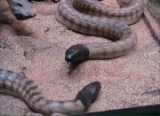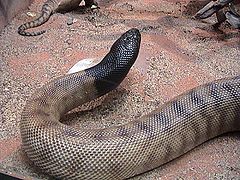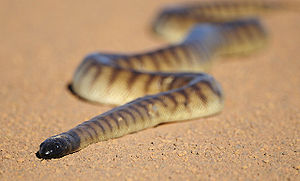
Black Headed Python
Encyclopedia
Aspidites melanocephalus, the Black-headed Python, is a species
of snake in the family Pythonidae (the python family) that is native to Australia
. No subspecies
are currently recognized.
 Adults grow to an average of 5 to 8.25 ft (1.5 to 2m) in length, but can grow to a maximum length of 2.5m, although average specimens are slightly smaller. The body is muscular with a flattened profile, while the tail tapers to a thin point.
Adults grow to an average of 5 to 8.25 ft (1.5 to 2m) in length, but can grow to a maximum length of 2.5m, although average specimens are slightly smaller. The body is muscular with a flattened profile, while the tail tapers to a thin point.
The dorsal scales
, which are smooth and glossy, number 50-65 rows at midbody, while there are 315-355 ventral scales
. The tail has 60-75 mainly single subcaudal scales
and the anal scale
is single. The posterior subcaudals tend to be divided, often irregularly.
The color pattern consists of shades of black and dark grey, brown, gold and cream arranged in a striped or brindled pattern. The belly light-coloured, flecked with darker spots. The head is covered in shiny black scales that also extend down the neck and throat for several inches.
in the northern half of the country, excluding the very arid regions. The type locality given is "Port Denison [Bowen]" [Queensland, Australia].

per clutch. The females stay coiled about the eggs and incubate them until they hatch, which is usually after 2-3 months. The young will take small prey as soon as two days after hatching. Immature individuals are vulnerable to predation, including cannibalism
. Adults have no natural predators other than dingo
s and human
s.
. It is bred in captivity
and can be relatively easily obtained, but does command a high price. As they can be muscular snakes and reach a fairly substantial size, prospective owners should consider a suitable enclosure, as well as temperature and feeding requirements.
Dreamtime
tradition.
Species
In biology, a species is one of the basic units of biological classification and a taxonomic rank. A species is often defined as a group of organisms capable of interbreeding and producing fertile offspring. While in many cases this definition is adequate, more precise or differing measures are...
of snake in the family Pythonidae (the python family) that is native to Australia
Australia
Australia , officially the Commonwealth of Australia, is a country in the Southern Hemisphere comprising the mainland of the Australian continent, the island of Tasmania, and numerous smaller islands in the Indian and Pacific Oceans. It is the world's sixth-largest country by total area...
. No subspecies
Subspecies
Subspecies in biological classification, is either a taxonomic rank subordinate to species, ora taxonomic unit in that rank . A subspecies cannot be recognized in isolation: a species will either be recognized as having no subspecies at all or two or more, never just one...
are currently recognized.
Taxonomic nomenclature
The taxonomic reference (Gr. Aspidites "shield bearer" melanocephalus "Black-headed") relates to the two large shield shaped scales on the top of the snakes head and the dark scales of the head and neck.Description

The dorsal scales
Dorsal scales
In snakes, the dorsal scales are the longitudinal series of plates that encircle the body, but do not include the ventral scales.When counting dorsal scales, numbers are often given for three points along the body, for example 19:21:17...
, which are smooth and glossy, number 50-65 rows at midbody, while there are 315-355 ventral scales
Ventral scales
In snakes, the ventral scales are the enlarged and transversely elongated scales that extend down the underside of the body from the neck to the anal scale. When counting them, the first is the anteriormost ventral scale that contacts the paraventral row of dorsal scales on either side...
. The tail has 60-75 mainly single subcaudal scales
Subcaudal scales
In snakes, the subcaudal scales are the enlarged plates on the underside of the tail. These scales may be either single or divided and are preceded by the anal scale....
and the anal scale
Anal scale
In snakes, the anal scale is the scale just in front of and covering the cloacal opening. This scale can be either single or paired . When paired, the division is oblique. It is preceded by the ventral scales and followed by the subcaudal scales....
is single. The posterior subcaudals tend to be divided, often irregularly.
The color pattern consists of shades of black and dark grey, brown, gold and cream arranged in a striped or brindled pattern. The belly light-coloured, flecked with darker spots. The head is covered in shiny black scales that also extend down the neck and throat for several inches.
Geographic range
Found in AustraliaAustralia
Australia , officially the Commonwealth of Australia, is a country in the Southern Hemisphere comprising the mainland of the Australian continent, the island of Tasmania, and numerous smaller islands in the Indian and Pacific Oceans. It is the world's sixth-largest country by total area...
in the northern half of the country, excluding the very arid regions. The type locality given is "Port Denison [Bowen]" [Queensland, Australia].
Habitat
Occurs in humid tropical to semi-arid conditions.
Behaviour
These snakes are terrestrial and are often found in amongst rocks and loose debris. If disturbed, they will hiss loudly, but are unlikely to bite unless hunting prey. They will sometimes strike with a closed mouth, but generally can be handled easily. They are strong swimmers, but are almost never found inside water. They are non-venomous.Feeding
The diet consists of mainly reptiles but will eat mammals if available. Because they live in the desert they heat up a lot quicker and they stay warmer for longer, meaning they can eat more because they digest food quicker in warmer conditions. When ingesting large prey this species positions one or two coils just ahead of its distended mouth and by constriction makes the task of swallowing easier.Reproduction
Oviparous, with 5-10 eggsEgg (biology)
An egg is an organic vessel in which an embryo first begins to develop. In most birds, reptiles, insects, molluscs, fish, and monotremes, an egg is the zygote, resulting from fertilization of the ovum, which is expelled from the body and permitted to develop outside the body until the developing...
per clutch. The females stay coiled about the eggs and incubate them until they hatch, which is usually after 2-3 months. The young will take small prey as soon as two days after hatching. Immature individuals are vulnerable to predation, including cannibalism
Cannibalism
Cannibalism is the act or practice of humans eating the flesh of other human beings. It is also called anthropophagy...
. Adults have no natural predators other than dingo
Dingo
The Australian Dingo or Warrigal is a free-roaming wild dog unique to the continent of Australia, mainly found in the outback. Its original ancestors are thought to have arrived with humans from southeast Asia thousands of years ago, when dogs were still relatively undomesticated and closer to...
s and human
Human
Humans are the only living species in the Homo genus...
s.
Captivity
Due to its docile nature and striking color pattern, this species has become very desirable as an exotic petExotic pet
An exotic pet is a rare or unusual animal pet, or an animal kept as a pet which is not commonly thought of as a pet.The definition is an evolving one; some rodents, reptiles, and amphibians have become firmly enough established in the world of animal fancy to no longer be considered exotic...
. It is bred in captivity
Captivity (animal)
Animals that live under human care are in captivity. Captivity can be used as a generalizing term to describe the keeping of either domesticated animals or wild animals. This may include for example farms, private homes and zoos...
and can be relatively easily obtained, but does command a high price. As they can be muscular snakes and reach a fairly substantial size, prospective owners should consider a suitable enclosure, as well as temperature and feeding requirements.
In human culture
These snakes are mentioned in, or play a central role in, the stories of the Indigenous AustraliansIndigenous Australians
Indigenous Australians are the original inhabitants of the Australian continent and nearby islands. The Aboriginal Indigenous Australians migrated from the Indian continent around 75,000 to 100,000 years ago....
Dreamtime
Dreamtime
In the animist framework of Australian Aboriginal mythology, The Dreaming is a sacred era in which ancestral Totemic Spirit Beings formed The Creation.-The Dreaming of the Aboriginal times:...
tradition.
External links
- The Creation Story of the Wardaman People at Renewing Women's Business. Accessed 19 September 2007.
- Black-Headed Python at Zoos Victoria. Accessed 19 September 2007.
- Aspidites melanocephalus at Pete Python Pete Reptiles. Accessed 19 September 2007.

